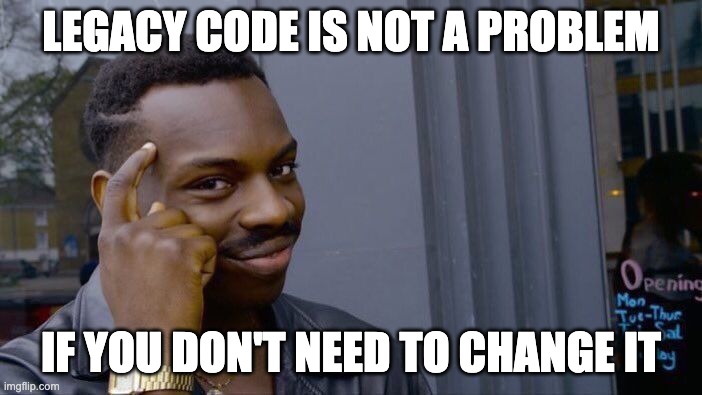Are functions that simply call another function a bad design choice?
⛑️️ My First Aid Kit can help you rescue any codebase quickly and safely!
Consider this line of code:
transaction.details.refundRequests.add(refundReference)If you ask experienced developers, they may tell you this code has a problem:
It violates the Law of Demeter!
Wait, what’s the Law of Demeter?
The Law of Demeter (LoD) is a design guideline to help you write maintainable Object-Oriented code.
It promotes “loose coupling” between classes with “information hiding”.
If classes know too much about each other, it’s harder to change them. When things are tightly coupled, a change somewhere has ripple effects everywhere: to change something, you need to touch everything! Loosely coupled means that you can change things independently. It’s easier to maintain.
That’s why LoD says: “Only talk to your immediate friends”.
The problem with the line of code above is that it shows too much about the transaction structure:
- It has a
detailsfield, - that has a
refundRequestsfield, - that has an
add()method.
Therefore, one could say “it violates the Law of Demeter”.
How to fix this design issue
That kind of code smell is frequent in Legacy Code. It even has a name: the Train Wreck.
When you start to notice it, you usually refactor the code like this:
transaction.addRefundRequest(refundReference)Well, that looks better!
To do so, you had to change the Transaction class:
class Transaction {
// … some irrelevant code
addRefundRequest(reference) {
this.details.refundRequests.add(reference)
}
}So far, so good.
But wait! You’re still not done. Now Transaction knows that the details have a refundRequest field, that has an add() method.
Law of Demeter blablabla, you continue to refactor and create a new method on TransactionDetails:
class TransactionDetails {
// … some irrelevant code
addRefundRequest(reference) {
this.refundRequests.add(reference)
}
}Now you can proudly use it in Transaction:
class Transaction {
// … some irrelevant code
addRefundRequest(reference) {
- this.details.refundRequests.add(reference)
+ this.details.addRefundRequest(reference)
}
}That seems better. Or does it?
Let’s take a step back and see the code you have now:
transaction.addRefundRequest(refundReference)
class Transaction {
// … some irrelevant code
addRefundRequest(reference) {
this.details.addRefundRequest(reference)
}
}
class TransactionDetails {
// … some irrelevant code
addRefundRequest(reference) {
this.refundRequests.add(reference)
}
}At this point, I’ve seen programmers stop and feel unsure about the refactoring.
The problematic part?
The addRefundRequest() of Transaction is just calling the same method on TransactionDetails 🤔
“These functions seem pretty redundant, it doesn’t feel smart to me…”
“I fear this is going to bite me somewhere down the line!”
Yeah… It’s normal you feel confused. There’s a valid question here:
Is it bad design to have a function that just calls another?
“A function that just calls another” is a code smell called a Middle Man.
Does that mean it’s a bad choice? Yep. Nope. It depends.
Say that a new feature comes in: you need to change the state of the Transaction when there’s a refund request. The encapsulation makes it easy to implement, with no impact on the calling code:
class Transaction {
// … some irrelevant code
addRefundRequest(reference) {
this.setPending()
this.details.addRefundRequest(reference)
}
}Now, if the feature never comes… then the original line of code maybe was fine.

“When you need to change it” is a great time to refactor the design.
A function that just calls another is not bad design by itself.
It’s a hint:
- If you compose objects together, you’ll probably have a few
- If you have many, then your code tries to tell you something about your design…
What matters is the level of abstraction
Hiding the information inside the Transaction class has another benefit: it’s an opportunity to name things!
Sure, naming is hard. But it expresses concepts. These concepts can represent different levels of abstraction.
This is well illustrated in this other (Java) example:
// Player is a high-level abstraction. "Being alive" is a generic idea.
// For the consuming code, that's all that matters.
bool isAlive = player.IsAlive();
// For a human player, "being alive" means the heart is.
// Heart is a lower-level abstraction. It's an implementation detail.
public class HumanPlayer : Player {
public bool IsAlive() {
return this.heart.IsAlive();
}
}
// For a robot, "being alive" is a question of boolean. Was it switched on?
public class RobotPlayer : Player {
public bool IsAlive() {
return this.IsSwitchedOn();
}
}Here, HumanPlayer.IsAlive() just looks like a Middle Man. But if we pay attention to our business, we may realize the names are off.
Rather than “being alive”, the heart “is beating”. Let’s express this:
public class HumanPlayer : Player {
public bool IsAlive() {
return this.heart.isBeating();
}
}And now you realize it looked like a Middle Man by accident. In fact, the levels of abstraction were different. This is what matters:
You should not mix concepts from different levels of abstractions.
What this means for the transaction
Let’s get back to our original example after our refactor:
class Transaction {
// … some irrelevant code
addRefundRequest(reference) {
this.details.addRefundRequest(reference)
}
}
class TransactionDetails {
// … some irrelevant code
addRefundRequest(reference) {
this.refundRequests.add(reference)
}
}What do you think Transaction.addRefundRequest() is telling you?
To me, it makes me think twice about the TransactionDetails concept. I’m not 100% sure this is a relevant abstraction. It looks more like a data structure detail. Maybe it would make sense to move the refundRequests directly under Transaction:
class Transaction {
// … some irrelevant code
addRefundRequest(reference) {
- this.details.addRefundRequest(reference)
+ this.refundRequests.add(reference)
}
}
class TransactionDetails {
// … some irrelevant code
- addRefundRequest(reference) {
- this.refundRequests.add(reference)
- }
}No more Middle Man.
Is it the right thing to do? I don’t know. It depends.
There’s an answer to this. To find it, you should talk to other people: business experts, other developers… Maybe no-one knows and that’s fine. You can keep it like that until it becomes a problem. Then you’ll know that you need to change the design.
Until then, it’s fine to have a function that just calls another one 🍻

Written by Nicolas Carlo
who lives and works in Montreal, Canada 🍁
He founded the Software Crafters Montreal
community which cares about building maintainable softwares.
Similar articles that will help you…

If you mock, are you even testing?
Is this the real code? Is this just fantasy? Let's discuss the problem with unit testing Legacy Code and an approach you can take.

Keeping dependencies up-to-date
My recipe for recovering from outdated dependencies and keeping healthy habits

A quick way to add tests when code has database or HTTP calls
You need to fix a bug, but you can't spend a week on it? Here's a technique to isolate problematic side-effects and write tests within minutes.

Is it fine to use "AND" in a function name?
Finding a better name for a function is hard, especially when people have contradictory opinions on what a good name looks like…